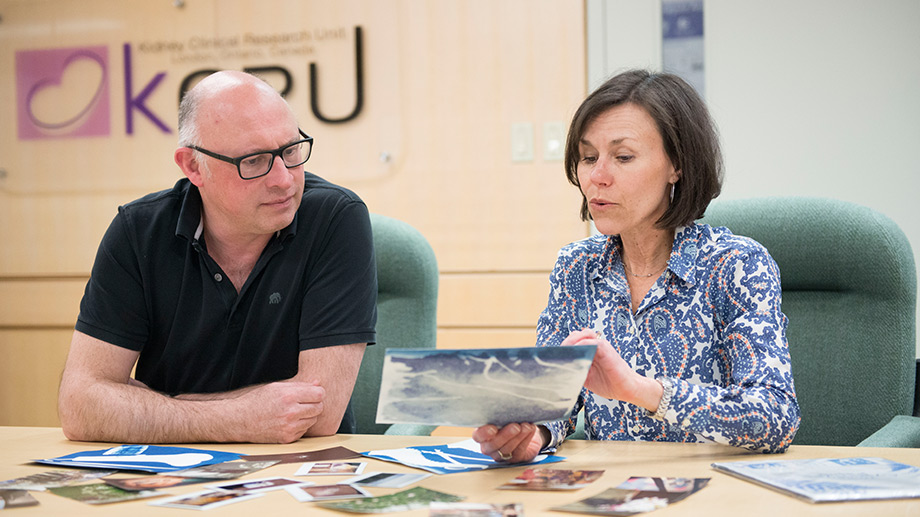The distant mountains
Are reflected in the eye
Of the dragonfly
This haiku by Japanese poet Kobayashi Issa is a fitting metaphor for this project says Dr. Christopher McIntyre.
The many facets of a dragonfly’s eye are the more than 1,500 photographs that research study participants took of their families, their pets, their homes and their scars - small snapshots of their lives on dialysis. But when all put together, they make up a common reflection. Like the distant mountains, they reflect a message of hope, resilience and healing.
“When the photos first came in we put them into piles, but we didn’t curate them. We didn’t try at first to elicit the messaging or context of them, we just let them sit and marinate, and then with time we started to see themes begin to emerge. And it wasn’t what we originally expected to find,” said Dr. McIntrye.

Dr. McIntrye and Cindy House
One of the first things the team noticed was that the photography wasn’t just serving as a communication tool but was also capable of being a change agent. The act of taking a photograph, of documenting one’s life, of making a decision of what to capture, was a way for patients to process emotions and to evaluate what is meaningful to them.
“One of the elements that we didn’t appreciate fully when we started this project was the idea that there is agency in the photographic process,” said Dr. McIntyre. “Rather that just using the cameras as a microphone to listen, it is actually capable of change in the people that are participating.”
During focus groups as part of the project, participants expressed how the project was meaningful for them, how it created focus in their lives and served as a way to spark discourse between patients about their individual journeys.
The researchers also realized the photography was not only an agent of change for the patients, but also for those viewing them, and for the researchers as well. “The photos made us redefine the question we thought we asked in light of the results and the feedback,” Dr. McIntyre said.
While they originally set out to try to uncover what made some patients more resilient than others in the face of their diagnosis, what they found instead was that every patient was at their own place in a journey of healing with many peaks and valleys along the way.
Dr. Eric Cassel famously wrote in a 1982 essay for the New England Journal of Medicine that “the relief of suffering and the cure of disease must be seen as twin obligations of a medical profession that is truly dedicated to the care of the sick.” And when he references ‘suffering’ he means not just physical pain but emotional suffering as well.
Dr. McIntyre says this is the distinction between curing and healing.
“Healing is the alleviation of suffering, it is the movement toward integrity and wholeness. In every single photograph, we see an individual window on some part of this healing process,” he said. “And not everyone’s journey is going to be the same.”
One of the most important aspects of this journey of healing is the redefining of self in the face of diagnosis. Even if the patient is cured through dialysis, they will never return to the person they once were before their illness.
Dialysis patients are often restricted in their daily lives – from what they can do physically, to what they can eat, and how far they can travel. They are required to attend dialysis clinics three to four times per week for hours at a time, sometimes travelling long distances to get there.
Dr. McIntyre says the photographs gave the researchers insight into how the participants viewed themselves and their identities in the face of these challenges. He said what came through in many of the images was the process of accepting the loss of meaningful activities, vocations and careers they could no longer do and moving toward a place of re-creation.
“Of course you have to mourn the loss of an old identity, because that’s a big part of coming to terms with it, but in the photos, we saw more a sense of discovery, finding out who they are now, or re-discovering themselves.”
What became clear was that participants very often photographed what was most important to them. Photos of a grandfather hugging a baby, a ruffled cat or a meticulously kept garden, all pointed to aspects of a participant’s life that were sources of stability, comfort and strength.
As a physician treating a patient, understanding that background is an important part of ensuring that a patient is supported and able to move forward with their treatment.
“That information might be as simple as understanding that someone has an enormous and supportive family, and that dialyzing at home might make all the difference to that person,” said Dr. McIntyre. “Now I know that understanding context in any patient I look after is going to be crucial.”

"Learnings: A healing journey" Written, filmed and edited by Crystal Mackay, MA'05
Sr. Media Relations Officer, Schulich Medicine & Dentistry